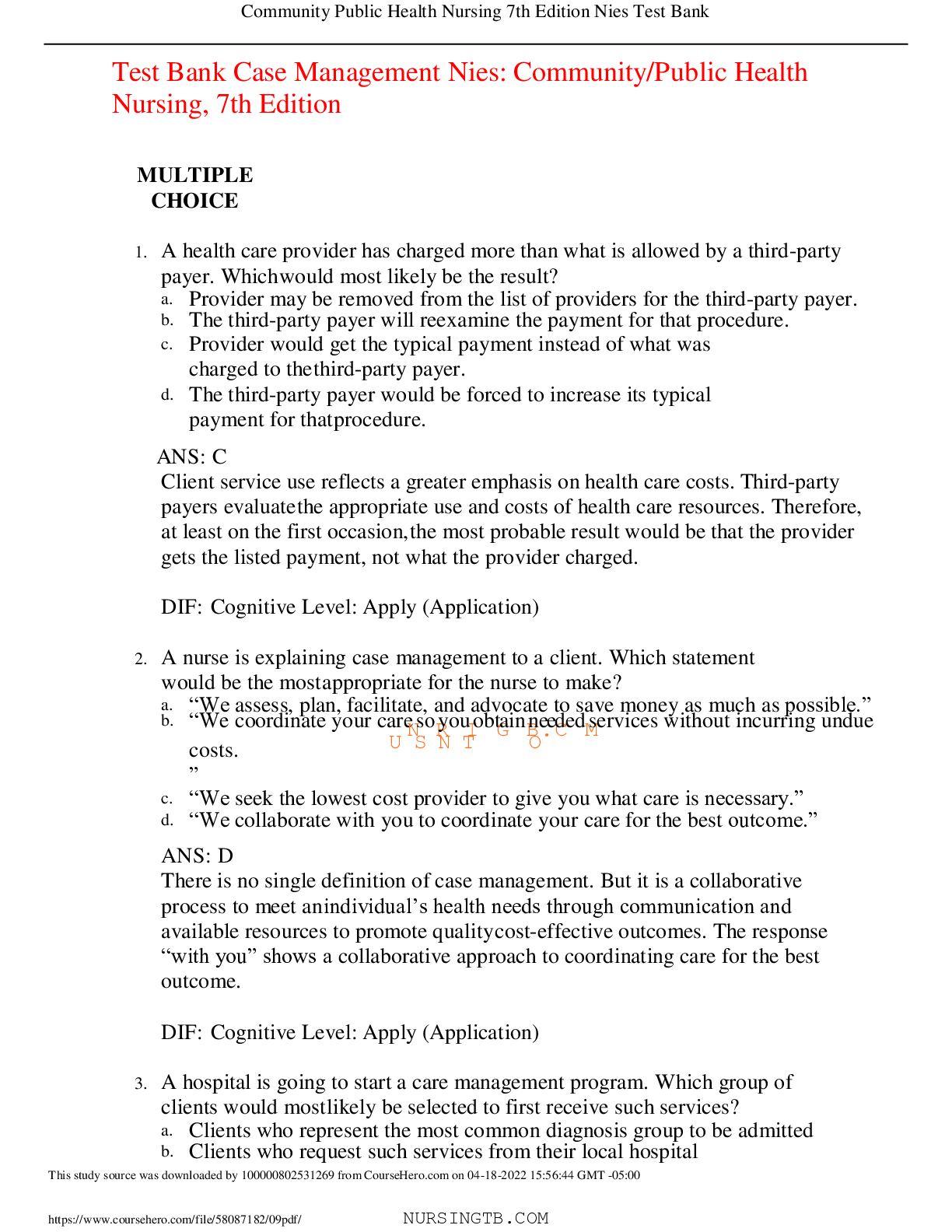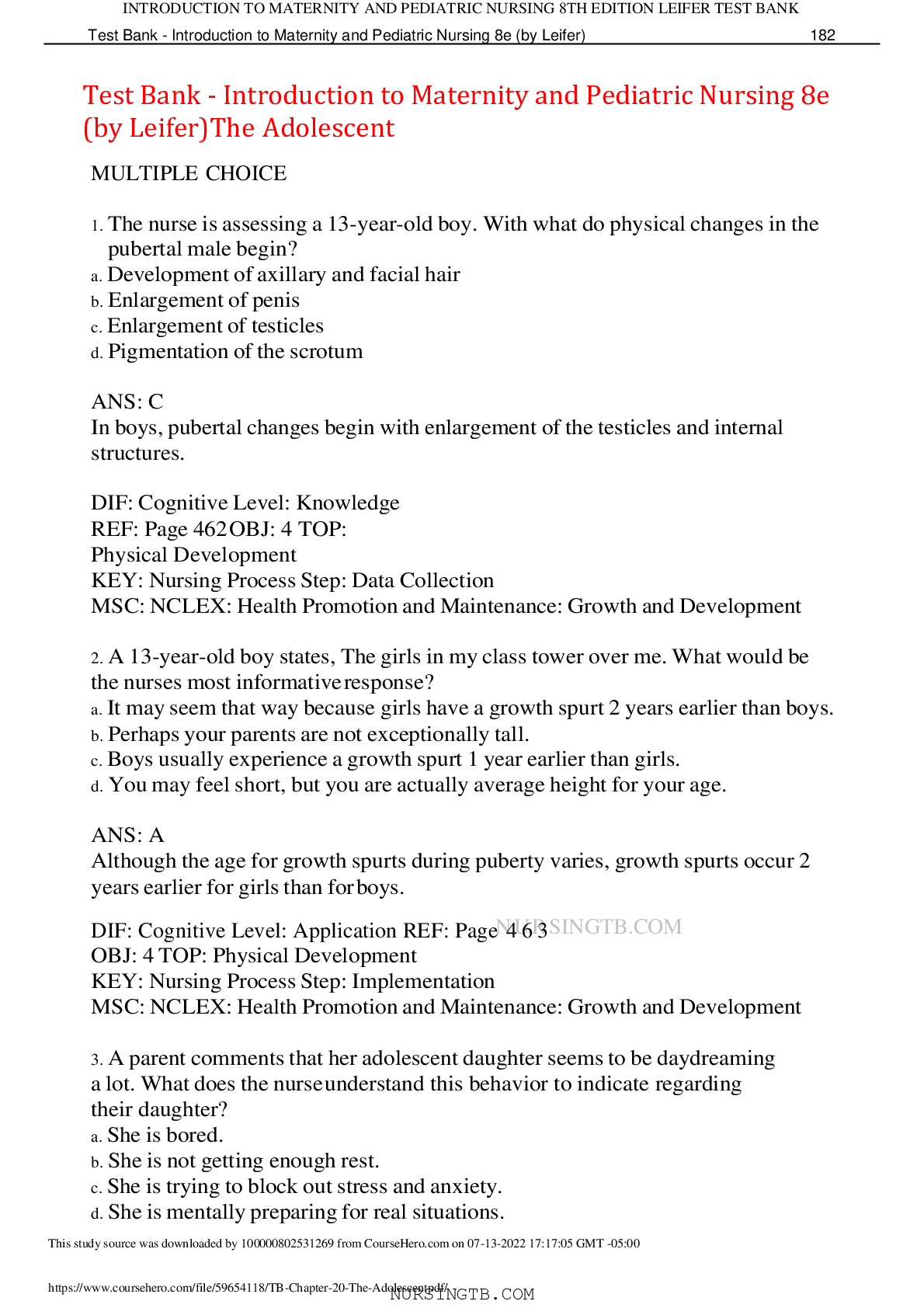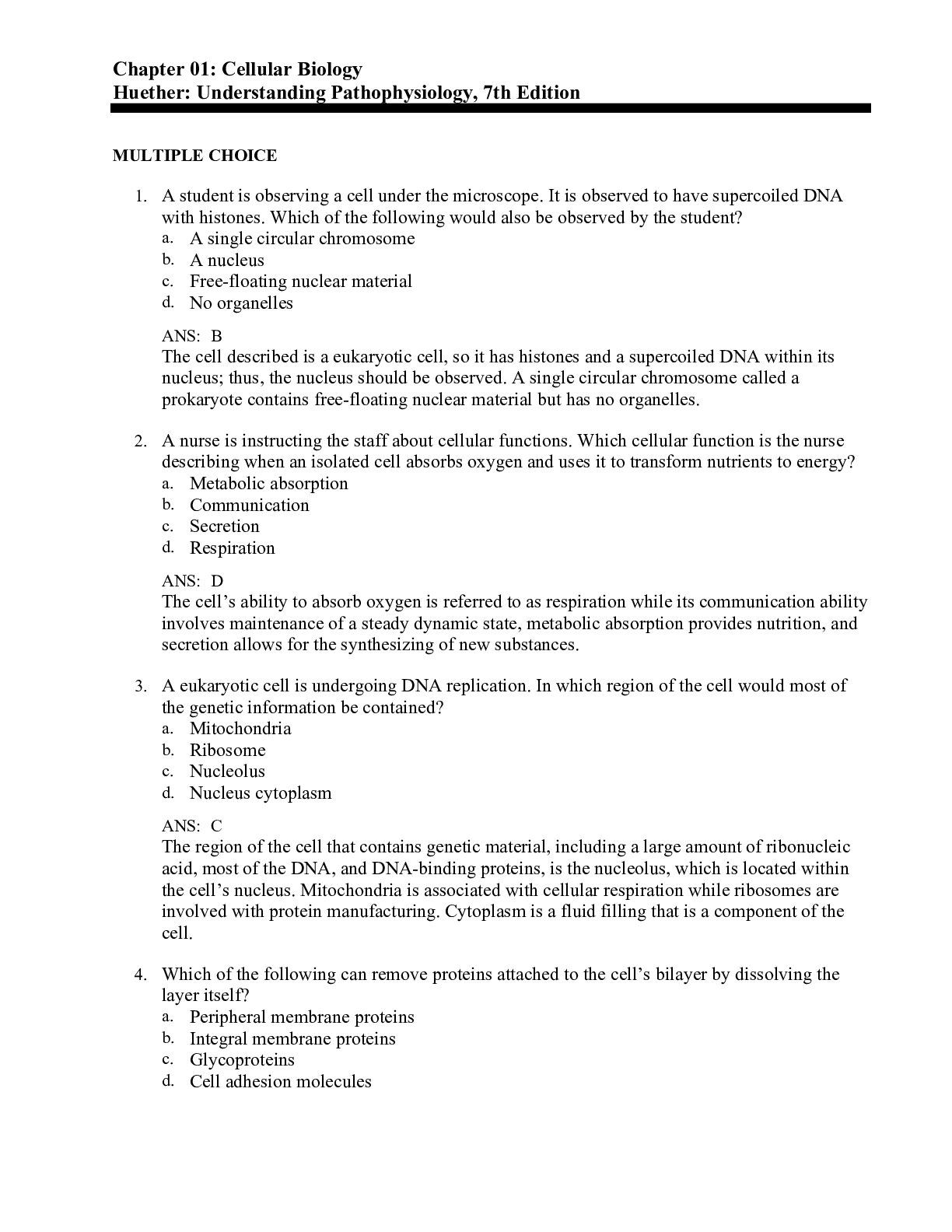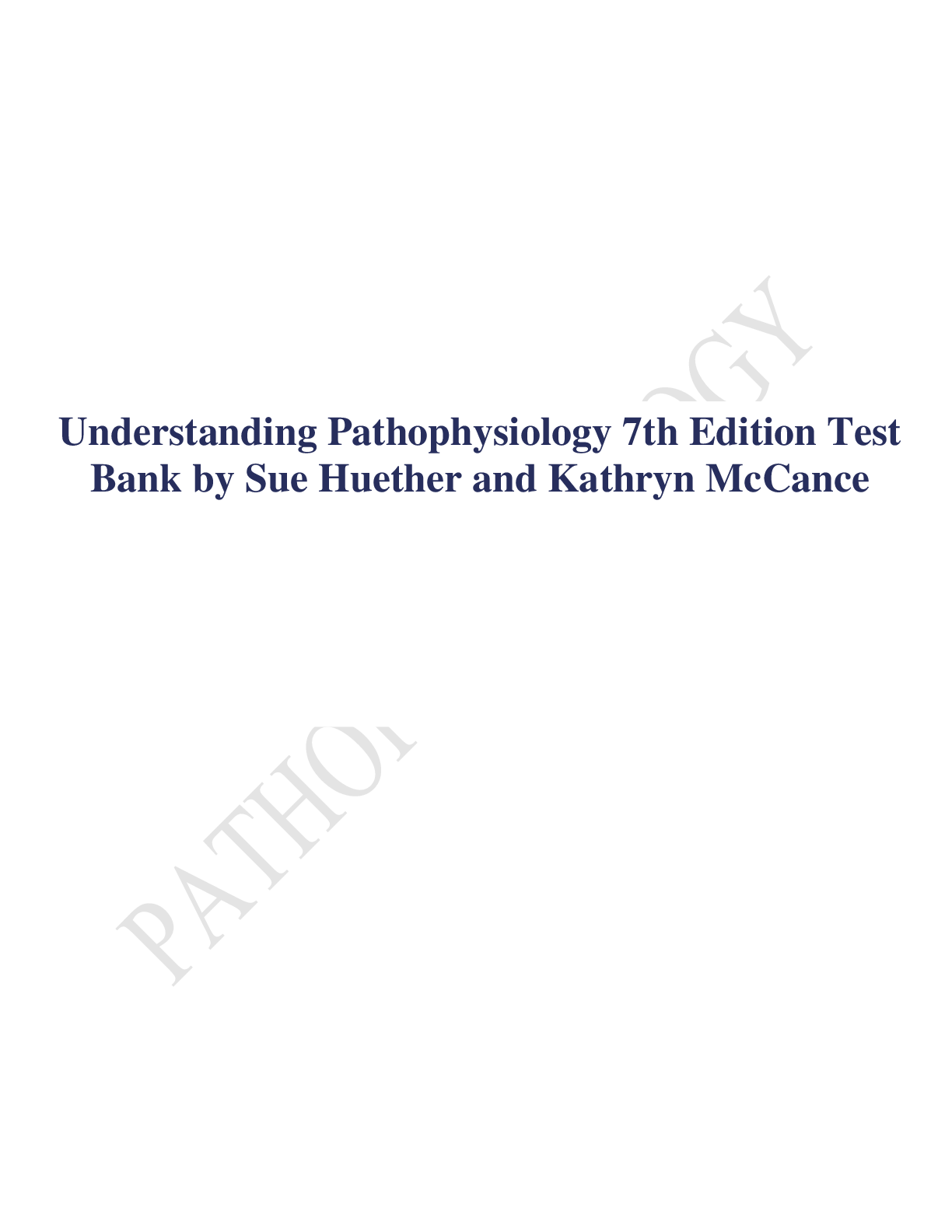*NURSING > TEST BANK > Test Bank: Altered Cellular and Tissue Biology Huether: Understanding Pathophysiology, 7th Edition,1 (All)
Test Bank: Altered Cellular and Tissue Biology Huether: Understanding Pathophysiology, 7th Edition,100% CORRECT
Document Content and Description Below
Test Bank: Altered Cellular and Tissue Biology Huether: Understanding Pathophysiology, 7th Edition MULTIPLE CHOICE 1. A report comes back indicating that muscular atrophy has occurred. A nurse... recalls that muscular atrophy involves a decrease in muscle cell: a. number. b. size. c. vacuoles. d. lipofuscin. ANS: B Atrophy is a decrease or shrinkage in cellular size. Hyperplasia is an increase in the number of cells. Vacuoles are membrane-bound vesicles within the cell that contain cellular debris and hydrolytic enzymes. Lipofuscin is the yellow-brown age pigment. 2. During childhood, the thymus decreases in size, and this is referred to as what type of atrophy? a. Physiologic b. Pathologic c. Disuse d. Neurogenic ANS: A A normal decrease in cell size is physiologic atrophy. Atrophy can result from disease (pathologic), disuse, or nerveNinUjuRrSy I(nNeGurKogIeNniGc.). COM 3. When planning care for a cardiac patient, the nurse knows that in response to an increased workload, cardiac myocardial cells will experience hypertrophy which is an: a. increase in size. b. decrease in length. c. increase in excitability. d. decrease in number. ANS: A Hypertrophy is a compensatory increase in the size of cells in response to mechanical stimuli (also called mechanical load or stress, such as from stretching, repetitive, chronic, pressure, or volume overload) and consequently increases the size of the affected organ. The cells of the heart and kidneys are particularly prone to enlargement. A decrease in length is not associated with hypertrophy. A deficiency of electrolytes or minerals could lead to an increase in excitability; it is not due to increased workload or related to hypertrophy. A decrease in cell numbers is referred to as hypoplasia. 4. A 55-year-old male with a 30-year history of smoking is examined for respiratory disturbance. Examination of his airway (bronchial) reveals that stratified squamous epithelial cells have replaced the normal columnar ciliated cells. This type of cellular adaptation is called: a. anaplasia. b. hyperplasia. c. metaplasia. d. dysplasia. ANS: C Metaplasia is the reversible replacement of one mature cell type by another, sometimes a less differentiated cell type. Anaplasia is loss of cellular differentiation. Hyperplasia is an increase in the number of cells resulting from an increased rate of cellular division. Dysplasia refers to abnormal changes in the size, shape, and organization of mature cells. 5. When planning care for the pregnant patient, the nurse will recall that the mammary glands enlarge as a consequence of: a. compensatory hyperplasia. b. hormonal hyperplasia. c. hormonal anaplasia. d. compensatory anaplasia. ANS: B An increase in the mammary glands during pregnancy is a result of hormonal changes. The number of mammary cells increases in response to increased hormone levels, not as a compensatory mechanism. Anaplasia is a reversal to less mature cells. 6. A 24-year-old female presents with excessive menstrual bleeding. The physician identified endometrial changes that are due to hormonal imbalances. These cellular changes would be referred to as: a. dysplasia. b. pathologic dysplasia. c. hyperplasia. d. pathologic hyperplasia. ANS: D NURSINGKING.COM Because the changes are due to an imbalance, they would be considered pathologic hyperplasia, a term more descriptive than simple hyperplasia. The endometrial changes were not abnormal in size and shape; thus, it is not dysplasia regardless of cause. 7. A 55-year-old male is diagnosed with hepatocellular cancer secondary to hepatitis C. If the cancerous region of the liver is removed, the remaining cells would undergo: a. pathologic hyperplasia. b. pathologic metaplasia. c. compensatory hyperplasia. d. compensatory aplasia. ANS: C Compensatory hyperplasia is an adaptive, not pathologic, mechanism that enables certain organs to regenerate. Metaplasia is the reversible replacement of one mature cell type by another, sometimes less differentiated, cell type. Aplasia is not a compensatory mechanism. 8. A 40-year-old female’s Pap smear indicates abnormal changes in the shape and organization of cervical cells. Which term would be used to identify this type of change? a. Metaplasia b. Atrophy c. Hypertrophy d. Dysplasia ANS: D When cervical cells undergo dysplasia, there is a change in their size, shape, and organization. Metaplasia is the reversible replacement of one mature cell type. The cells have not decreased in size; therefore, atrophy is incorrect. The cells have not increased in size in response to stimuli; therefore, they have not hypertrophied. 9. A 75-year-old male presents with chest pain on exertion. The chest pain is most likely due to hypoxic injury secondary to: a. malnutrition. b. free radicals. c. ischemia. d. chemical toxicity. ANS: C The cardiac cells are deprived of oxygen, leading to ischemia, a reduction in blood supply to tissues. The cells are deprived of oxygen; they are not malnourished. Free radicals are electrically uncharged atoms or groups of atoms that have an unpaired electron. Chemical toxicity is not a factor in the chest pain. 10. A patient has a heart attack that leads to progressive cell injury that causes cell death with severe cell swelling and breakdown of organelles. What term would the nurse use to define this process? a. Adaptation b. Calcification c. Apoptosis d. Necrosis ANS: D NURSINGKING.COM Necrosis is the sum of cellular changes after local cell death. Cellular adaptation is a reversible, structural, or functional response to both normal or physiologic conditions and adverse or pathologic conditions. Calcification is an accumulation of calcium salts. Apoptosis is an active process of cellular self-destruction. 11. Sodium and water accumulation in an injured cell are a direct result of: a. decreased ATP production. b. karyorrhexis. c. ribosome detachment. d. dehydration. ANS: A A reduction in ATP levels causes the plasma membrane’s sodium–potassium (Na+-K+) pump and sodium-calcium exchange to fail. Sodium and water can then enter the cell freely. Karyorrhexis means fragmentation of the nucleus into smaller particles or “nuclear dust.” Ribosome detachment reduces protein synthesis. Dehydration leads to loss of sodium and water. 12. The early dilation (swelling) of the cell’s endoplasmic reticulum results in: a. increased aerobic metabolism. b. failure of DNA. c. reduced protein synthesis. d. increased Na+–K+ pump function. ANS: C Early dilation of the endoplasmic reticulum causes the ribosomes to detach from the rough endoplasmic reticulum, reducing protein synthesis. Aerobic metabolism is a normal process and would not lead to swelling. Cellular swelling will not alter cellular DNA. A reduction in the Na+–K+ pump leads to an intracellular accumulation of sodium and calcium and diffusion of potassium out of the cell. Sodium and water can then enter the cell freely, and cellular swelling results. 13. A 52-year-old male suffered a myocardial infarction secondary to atherosclerosis and ischemia. Once blood flow is returned to the damaged heart, reperfusion injury occurs as a result of: a. oxidation stress. b. vacuolation. c. decreased intracellular calcium. d. lipid acceptor proteins. ANS: A Reperfusion injury can result from oxidative stress, increased intracellular calcium, inflammation, or complement activation. Oxidative stress causes the formation of radicals that cause further membrane damage and mitochondrial calcium overload. Vacuolation leads to cellular swelling but is not associated with reperfusion. An increase of intracellular calcium is a cause of reperfusion injury. Lipid acceptor proteins bind with triglycerides to create fatty liver, and they do not affect the myocardium. 14. A family presents to their primary care provider reporting headache, nausea, weakness, tinnitus, and vomiting. Which of the following would be the most likely explanation for these symptoms? a. Lead exposure NURSINGKING.COM b. Carbon monoxide poisoning c. Ethanol exposure d. Mercury poisoning ANS: B Symptoms related to carbon monoxide poisoning include headache, giddiness, tinnitus (ringing in the ears), nausea, weakness, and vomiting. Although nausea and vomiting can occur with lead exposure, lead toxicity is primarily manifested by convulsions and delirium and, with peripheral nerve involvement, wrist, finger, and sometimes foot paralysis. Ethanol exposure has CNS effects and would not affect the whole family. Mercury poisoning is manifested by CNS effects and would not lead to nausea and vomiting. 15. A common pathway of irreversible cell injury involves increased intracellular: a. sodium. b. potassium. c. magnesium. d. calcium. ANS: D Increased intracellular calcium levels activate cell enzymes (caspases) that promote cell death by apoptosis. Persistent ischemia is associated with irreversible injury and necrosis. Irreversible injury is associated structurally with severe swelling of the mitochondria, severe damage to plasma membranes, and swelling of lysosomes. Cellular injury is not associated with sodium, potassium, or magnesium levels. 16. A 50-year-old male sustained a closed head injury as a result of a motor vehicle accident. CT scan revealed a collection of blood between the inner surface of the dura mater and the surface of the brain. Which type of injury will the nurse be caring for? a. Subdural hematoma b. Epidural hematoma c. Contusion d. Abrasion ANS: A A subdural hematoma occurs when blood is between the inner surface of the dura mater and the surface of the brain; it can result from blows, falls, or sudden acceleration/deceleration of the head. An epidural hematoma is a collection of blood between the inner surface of the skull and the dura; it is most often associated with a skull fracture. A contusion is bleeding into the skin or underlying tissues. An abrasion (scrape) results from removal of the superficial layers of the skin caused by friction between the skin and injuring object. 17. A 20-year-old male presents to the emergency department with a jagged sharp-force injury that is longer than it is deep. Which type of wound will the nurse be caring for? a. Stab wound b. Incised wound c. Puncture wound d. Chopping wound ANS: B NURSINGKING.COM An incised wound is a cut that is longer than it is deep. A stab wound is a penetrating sharp-force injury that is deeper than it is long. A puncture wound is without sharp edges and is made with an instrument like a nail. Heavy, edged instruments (axes, hatchets, propeller blades) produce wounds with a combination of sharp and blunt force characteristics. 18. A 30-year-old female presents with a gunshot wound to the head. The wound has seared edges and a deep penetration of smoke and gunpowder fragments. This wound would be documented as a(n): a. exit. b. intermediate range entrance. c. contact range entrance. d. indeterminate range entrance. ANS: C A contact range entrance wound is a distinctive type of wound that happens when a gun is held so the muzzle rests on or presses into the skin surface; in addition to the hole, there is searing of the edges of the wound from flame and soot or smoke on the edges of the wound. It is unlikely it is an exit wound since there is only one wound and it has seared edges and gunpowder fragments. An intermediate range entrance wound is surrounded by gunpowder tattooing or stippling. An indeterminate range entrance wound occurs when flame, soot, or gunpowder does not reach the skin surface but the bullet does. 19. A 15-year-old female presents to the ER following a physical assault. She has internal damage to the neck with deep bruising. X-ray reveals fractures of the hyoid bone and tracheal and cricoid cartilage. Which of the following most likely caused her injuries? a. Chemical asphyxiation b. Choking asphyxiation c. Ligature strangulation d. Manual strangulation ANS: D Squeezing of the neck as with strangulation would fracture the hyoid bone. Chemical asphyxiation would lead to breathing problems but would not result in fracture. Choking asphyxiation would lead to swelling of tissues but would not result in fracture. In ligature strangulation, the mark on the neck is horizontal without the inverted V pattern seen in hangings. It would not lead to fracture. 20. A 55-year-old male has swelling of the feet. Which of the following aided in the development of swelling? a. Increased ATP b. Chloride movement out of the cell c. Na+ movement into the cell d. Decreased oncotic pressure ANS: C When sodium and water enter the cell freely, cellular swelling, as well as early dilation of the endoplasmic reticulum, results. Decreased ATP would lead to swelling. Chloride movement out of the cell would affect muscle contraction but does not lead to swelling. Increased oncotic pressure would not afNfeUcRt sSwIeNlliGngK.ING.COM 21. A 35-year-old female is diagnosed with multiple myeloma. Biopsy of the tumor reveals Russell bodies, and laboratory testing reveals kidney dysfunction. Which substance should the nurse monitor as it is accumulating in the patient’s body? a. Glycogen b. Protein c. Pigment d. Melanin ANS: B Russell bodies occur due to excess aggregates of protein. Excess glycogen would affect blood glucose. Increased pigment would not lead to kidney dysfunction. Melanin accumulates in epithelial cells (keratinocytes) of the skin and retina. 22. A newborn male is diagnosed with albinism based on skin, eye, and hair appearance. Which finding will support this diagnosis? a. Increased melanin b. Increased hemoproteins c. Inability to convert tyrosine to DOPA (3,4-dihydroxyphenylalanine) d. Inability to convert bile to bilirubin ANS: C The person with albinism is unable to convert tyrosine to DOPA, an intermediate in melanin biosynthesis. An increase in melanin would cause skin to be darker. Hemoprotein accumulations in cells are caused by excessive storage of iron, which is transferred to the cells from the bloodstream. An inability to convert bile to bilirubin would not lead to albinism. 23. A 23-year-old male develops a black eye following a fight. When the aide asks the nurse why this occurred, the nurse’s best response is that the bruising is due to an accumulation of: a. transferrin. b. bilirubin. c. albumin. d. hemosiderin. ANS: D Hemosiderin is responsible for the color changes in a black eye. Transferrin is a transport protein responsible for iron transport. Bilirubin is the normal, yellow-to-green pigment of bile derived from the porphyrin structure of hemoglobin. Albumin is the protein in the serum, responsible for cellular integrity. 24. Liquefactive necrosis occurs in the brain because: a. debris is not digested by hydrolases. b. of protein denaturation. c. it is rich in hydrolytic enzymes and lipids. d. ischemia results in chemical injury. ANS: C Liquefactive necrosis is due to enzymatic action and because cells of the brain are rich in enzymes. Protein denaturation occurs primarily in the kidneys. Liquefactive necrosis is due to enzymatic reaction and not toNhUyRpoSxIiaNoGr KhyIdNroGla.sCesO. M 25. A 2 year old swallowed watch batteries. Following ingestion, kidney function was impaired, and the heart began to fail. Which of the following was the most likely cause? a. Karyorrhexis b. Coagulative necrosis c. Ammonia accumulation d. Caseous necrosis ANS: B Coagulative necrosis occurs primarily in the kidneys, heart, and adrenal glands and commonly results from hypoxia. Karyorrhexis means fragmentation of the nucleus into smaller particles or “nuclear dust.” Ammonia accumulation is not associated with this toxicity. Caseous necrosis results from tuberculosis pulmonary infection. 26. A group of prison inmates developed tuberculosis following exposure to an infected inmate. On examination, tissues were soft and granular (like clumped cheese). Which of the following is the most likely cause? a. Coagulative necrosis b. Liquefactive necrosis c. Caseous necrosis d. Auto necrosis ANS: C Caseous necrosis results from tuberculosis pulmonary infection. Coagulative necrosis occurs primarily in the kidneys, heart, and adrenal glands, and commonly results from hypoxia. Liquefactive necrosis results from ischemic injury to neurons and glial cells in the brain. Autonecrosis is a process of cellular self-digestion and is not due to infection such as tuberculosis. 27. A 50-year-old female became infected with Clostridium bacteria and died a week later. Examination of her red blood cells revealed lysis of membranes. Which of the following was the most likely cause of her death? a. Fat necrosis b. Wet gangrene c. Gangrenous necrosis d. Gas gangrene ANS: D Gas gangrene is a special type of gangrene caused by infection of injured tissue by one of many species of Clostridium. Fat necrosis is cellular dissolution caused by powerful enzymes, called lipases, that occur in the breast, pancreas, and other abdominal structures. Wet gangrene develops when neutrophils invade the site, causing liquefactive necrosis. Gangrenous necrosis is due to death of tissue and results from severe hypoxic injury. 28. While reading a textbook, a student reads the term apoptosis. The student recalls that apoptosis is a condition in which cells program themselves to: a. atrophy. b. die. c. regenerate. d. age. ANS: B NURSINGKING.COM In apoptosis, cells are programmed to die. Apoptosis is not associated with cell atrophy, regeneration, or aging. 29. A 50-year-old male intravenous drug user is diagnosed with hepatitis C. Examination of the liver reveals cell death secondary to: a. fat necrosis. b. physiologic apoptosis. c. infection-induced apoptosis. d. pyknosis. ANS: C With hepatitis C, the liver will demonstrate apoptosis that is a result of the viral infection. Fat necrosis occurs with enzymatic action due to lipases. Apoptosis is not a normal physiologic process. Pyknosis occurs when the nucleus shrinks and becomes a small, dense mass of genetic material. 30. What principle should the nurse remember when trying to distinguish aging from diseases? a. It is difficult to tell the difference because both processes are believed to result from cell injury. b. It is easy to tell normal processes from abnormal processes. c. Disease, unlike aging, has a genetic component. d. Aging is defined as exceeding life expectancy, but not maximal life span. ANS: A It is difficult to differentiate between aging and disease because both occur secondary to cellular aging. It is not easy to differentiate normal processes from abnormal because aging appears as a normal process. Disease and aging have a possible genetic component. Aging is a time-dependent loss of structure and function that proceeds slowly and in such small increments that it appears to be the result of the accumulation of small, imperceptible injuries. It is not a time period outside of life expectancy. 31. When a nurse observes muscle stiffening occurring within 6–14 hours after death, the nurse should document this finding as the presence of: a. livor mortis. b. gangrene. c. algor mortis. d. rigor mortis. ANS: D Rigor mortis occurs within 6 hours after death and is evidenced by muscle stiffening. Livor mortis is a purple discoloration. Gangrene refers to death of tissue and results from severe hypoxic injury and does not lead to stiffening. Algor mortis is postmortem reduction of body temperature. 32. When a nurse is checking a urinalysis, the finding that would alert the nurse to cellular injury is the presence of: a. slight glucose. b. excessive protein. c. blood. d. urea. ANS: B NURSINGKING.COM The presence of protein in the urine in significant amounts indicates cellular injury and altered cellular function. Neither glucose nor blood is normally present in the urine, but its presence is not indicative of altered cellular function. Urea is an expected substance in the kidney. 33. An 86-year-old female patient has the wasting syndrome of aging, making her vulnerable to falls, functional decline, disease, and death. The nurse knows this patient is experiencing: a. frailty. b. sarcopenia. c. somatic death. d. cellular aging. ANS: A Frailty leaves the individual vulnerable to falls, disease, and death. Sarcopenia is loss of muscle mass. It is associated with aging but is not as severe as frailty. Somatic death is death of the whole person. Cellular aging occurs at the cellular level and is characteristic of aging, including cell atrophy, decreased function, and loss of cells. 34. Confirmation of somatic death is based on: a. presence of algor mortis. b. presence of livor mortis. c. complete cessation of respiration and circulation. d. change in skin color to pale yellow. ANS: C The most notable manifestations are complete cessation of respiration and circulation. Algor mortis is postmortem reduction of body temperature and is not confirmation of somatic death. Livor mortis is muscle stiffening and is not confirmation of somatic death. Change in skin color to pale yellow does occur, but complete cessation of respiration and circulation confirms somatic death. MULTIPLE RESPONSE 1. A patient has been reading on the Internet that light to moderate intake of alcohol is cardioprotective. When the patient asks the nurse what this means, the nurse should respond that the heart is protected by which of the following mechanisms? (Select all that apply.) a. Increased levels of high-density lipoprotein cholesterol b. Prevention of clot formation c. Reduction in platelet aggregation d. Decrease in blood pressure e. Increased collateral circulation f. Decreased folate absorption ANS: A, B, C, D The suggested mechanisms for cardioprotection by low to moderate alcohol intake include increased levels of high-density lipoprotein cholesterol (HDL-c), prevention of clot formation, reduction in platelet aggregation, and decrease in blood pressure. Increased collateral circulation is not a benefit of alcohol. Alcohol consumption can decrease folate absorption, which can lead to a nutritionaNl UdeRfiSciIenNtG. KING.COM 2. After ingestion of lead, what organ systems should the nurse monitor because they are the most sensitive to the effects of lead? (Select all that apply.) a. Heart b. Lungs c. Liver d. Kidneys e. Brain f. Hematopoietic ANS: D, E, F The organ systems primarily affected by lead ingestion include the nervous system (brain), the hematopoietic system (tissues that produce blood cells), and the kidneys. The heart, liver, and lungs are not affected. [Show More]
Last updated: 1 year ago
Preview 1 out of 10 pages
Instant download

Instant download
Reviews( 0 )
Document information
Connected school, study & course
About the document
Uploaded On
Nov 05, 2021
Number of pages
10
Written in
Additional information
This document has been written for:
Uploaded
Nov 05, 2021
Downloads
0
Views
109



























